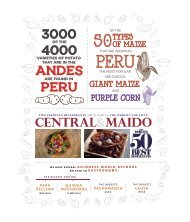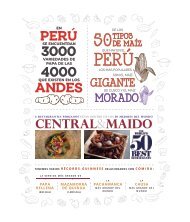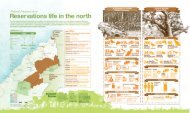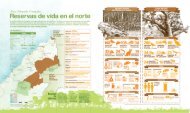UJ #17 - Traditional Peru
Create successful ePaper yourself
Turn your PDF publications into a flip-book with our unique Google optimized e-Paper software.
NOVEMBER | DAY OF THE DEATH<br />
Diego Oliver<br />
Death is not always synonymous with sadness. In fact,<br />
many cultures – including ancient <strong>Peru</strong>vians like the<br />
Moche and Incas – see death as a rite of passage into<br />
the “next life.” Proof of this is that many ancient peoples<br />
were buried with their belongings and sometimes even<br />
with other people in order to make sure that these things<br />
would accompany them in their journey to the next world.<br />
Mexico’s infamous festivities are generally what come<br />
to mind when thinking about the Day of the Dead.<br />
Nonetheless, each country has its own customs to<br />
commemorate those no longer with us, and <strong>Peru</strong> is no<br />
exception. In the Andes, guaguas replace Mexico’s sugar<br />
skeletons, and altars are modified in accordance to local<br />
Andean traditions.<br />
During the Spanish rule, people were buried in catacombs<br />
close to the churches in order to be “closer to God.” In<br />
1808, Lima’s first cemetery – the Presbiterio Maestro –<br />
was inaugurated, and became the last stop for the city’s<br />
aristocrats. Today, over 200 years and countless cultural<br />
and urban changes later, there is a new Lima cemetery<br />
that is getting the attention: Nueva Esperanza, located in<br />
Diego Oliver<br />
the peripheral district of Villa Maria del Triunfo.<br />
Since 1961, over one million people – many of them<br />
descendants of migrants who came from the country’s<br />
rural areas – have been buried in the cemetery’s 60<br />
hectares. Hundreds of small houses and colourful<br />
niches decorate the sandy landscape that spans across<br />
the hillsides. To enter this cemetery on the 1st or 2nd<br />
of November is to enter another dimension. Beyond<br />
the customary flowers and balloons, people arrive to<br />
celebrate their loved ones with musicians, bottles of their<br />
favourite liquors, and typical dishes from their places of<br />
origin, gradually turning this small city of the dead into<br />
one huge party.<br />
For many, the<br />
Nueva Esperanza<br />
Cemetery is like a<br />
small city. There<br />
are even some<br />
peculiar “buildings,”<br />
like this one.<br />
Provinces like Cajamarca and Arequipa celebrate the day<br />
with the popular guagua breads. These sweet breads are<br />
made from a special recipe, and decorated with sugar<br />
THE FIRST CHRISTIANS CELEBRATED<br />
THE DEAD FOR ONE WEEK DURING<br />
THE MONTH OF FEBRUARY. IT WAS<br />
NOT UNTIL THE X CENTURY THAT THE<br />
2ND OF NOVEMBER WAS CHOSEN AS<br />
THE OFFICIAL COMMEMORATIVE DATE.<br />
72<br />
Entire families congregate to<br />
spend the Day of the Dead with<br />
their deceased family member.

















